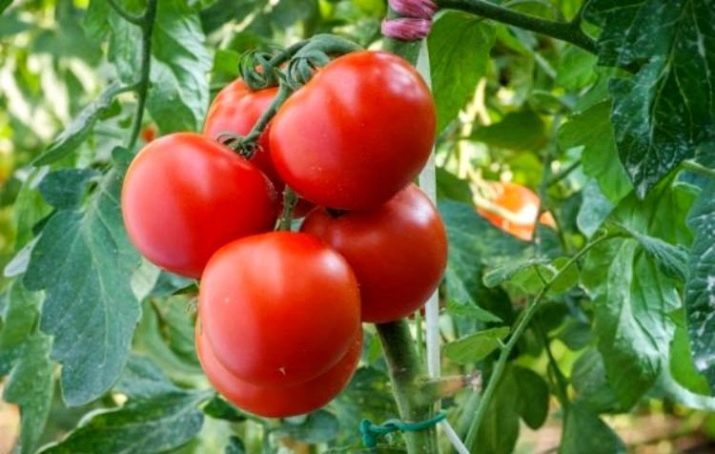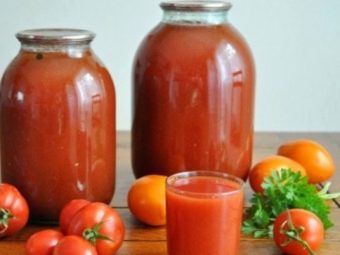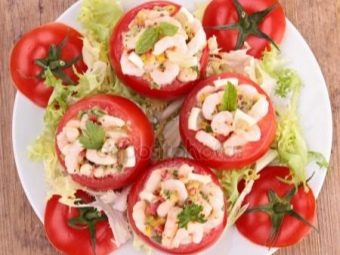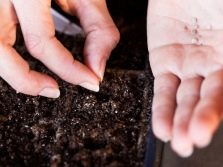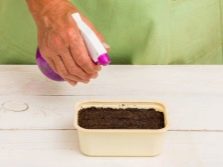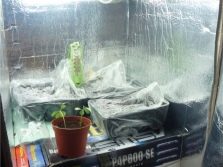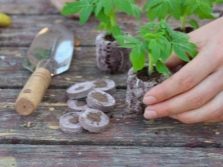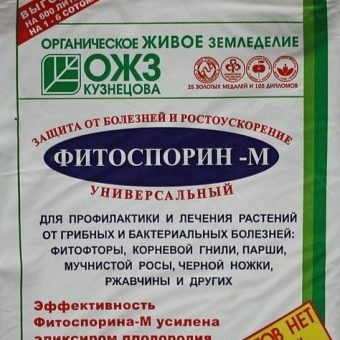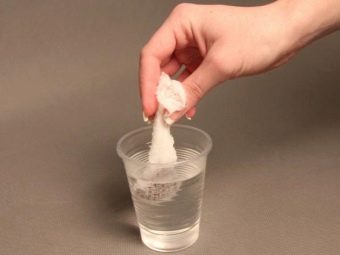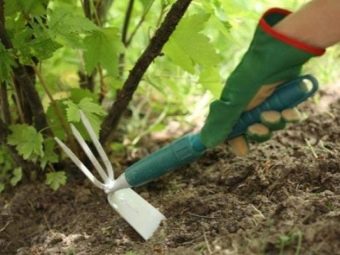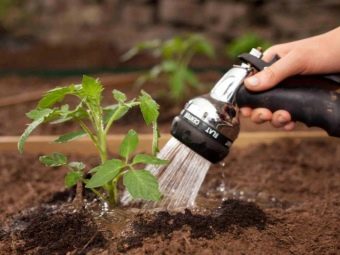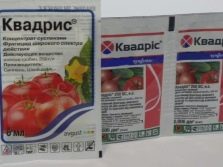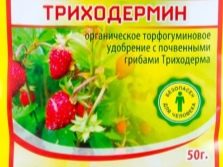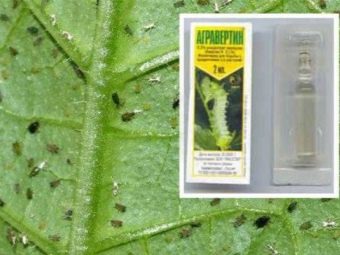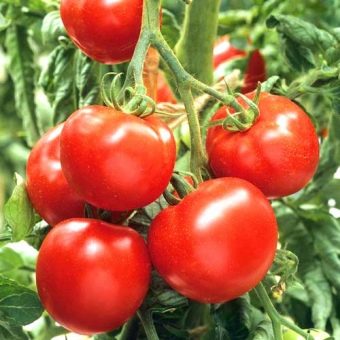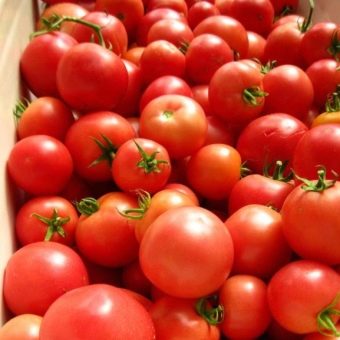What are the peculiarities of the tomato variety “Polufast F1” and how to grow it?
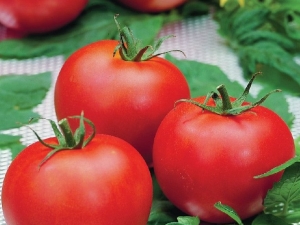
Tomato "Half fast F1" refers to the early Dutch hybrids. This variety is distinguished by its fast ripening, excellent taste and high yield.Of course, proper planting, care and watering significantly affect the fertility of tomatoes.
Main characteristics
The early ripe cultivar of tomatoes “Half-fast F1” is a low-growing shrub about 60–70 cm tall with an average weight of large dark green leaves, but when sheltered with a film or in a greenhouse, the bushes usually do not grow above 40 cm. of the month. The plant feels great outdoors in warm climates with moderate humidity. In greenhouses, these tomatoes can also be grown if the soil is sufficiently fertilized.
The variety of tomatoes "Polufast F1" has the following obvious advantages:
- Tomatoes have a good setting at any temperature, they are more resistant to various diseases, such as fusarium and verticillus, than traditional varieties;
- the bush does not require special formation due to its compactness; plants can be planted at short distances from each other (40–50 cm);
- good yields - there is an opportunity to get up to six kilograms of a quality product from a square meter of land;
- the flesh of this variety is fleshy, contains very little water and seeds, but it is very juicy and useful with lots of vitamins and natural saccharides;
- resistance to dry and cold weather, in which the fruits are still tied and matured, makes the variety desirable for many farmers.
Tomatoes are formed by whole brushes up to 6 pieces each, have an average size and a rounded shape. As they mature, they acquire a pronounced red color. The distinctive characteristic of the variety is a thin peel that prevents them from cracking. Their weight can reach 100–140 g. The largest tomatoes are located on the lower branches, but they are much smaller.
An additional advantage is that the hybrid can be stored for a long time and preserve its taste and useful qualities. Green fruits in a room with an average temperature of + 18–20 degrees ripen quickly and turn red. This variety does not actually have minuses, except that it is not possible to gather its seeds, since the plant is a hybrid.
Such tomatoes can be used to make pasta, juice, used in the form of side dishes and first course ingredients.
Growing seedlings
The culture is pretty unpretentious. You can plant seedlings in early spring, beginning in late March or early April. If you are planting in the greenhouse, it is carried out in May. The substrate must be prepared beforehand, light but maximally nutritious. It is prepared from the following components:
- garden soil, resulting from rotting the leaves of fruit and tree species;
- humus (humus) is an organic substance based on manure and plant elements, obtained by decomposition of aerobic and anaerobic bacteria;
- friable and rather large river sand, previously washed, which improves the structure of the soil, allows it to retain heat and moisture longer;
- wood ash, which is a source of sodium, calcium and other trace elements important for plant growth.
Before planting in containers it is important to spray the earth with warm water. Planting seeds should be at a depth of no more than two centimeters for rapid germination. Immediately after sowing, cover the trays with film. The optimal air temperature is + 23-25 degrees. When the first shoots appear, the containers with plants are moved to a lighter and cooler place.
Light is an important indicator for the development and growth of tomatoes, so if it is lacking, it will be necessary to provide additional lighting in the form of fluorescent lamps.
Transplant and care
The picking of plants, that is, their transplantation, is carried out when two formed leaves appear on them. In the same period, additional fertilizer is fed with complex mineral fertilizer, which includes potassium, phosphorus, nitrogen and other elements.A few days later, tomatoes are tied up. Fruiting on open ground usually begins in 50–54 days. For irrigation should be used softened, warm water, drying out of the soil is unacceptable.
Seedlings should be properly planted by following these steps:
- when planted in open soil between the plants, a distance of half a meter is observed;
- if picking occurs in a greenhouse, the interval between tomatoes can be reduced to 20–30 cm;
- pits with a depth of 30 cm are pulled out in the ground, 2–3 branches are placed there, then the crop is watered, which ensures high fruit productivity of the bush.
First, the tomato grows vigorously in height, after which there is a sprouting around the roots. The optimum watering of the plant is up to six times a month, during the rains the hybrid needs additional fertilizer with nitrogen compounds. If tomatoes are grown in the arid hot zone, irrigation of the root system will be required every two days.
A few weeks before harvesting, it is necessary to stop fertilization in the soil, and if spraying against diseases and pests is necessary, then only natural harmless means are used.
Disease prevention
"Half fast F1" - a variety that is highly resistant to various diseases of tomatoes. This is due to the fact that the seeds are pretreated and fully prepared for sowing, so they do not need rinsing and other procedures, as this can be washed away useful, protective layer.
Immediately in the ground can be planted and seedlings with the root system, treated with Fitosporin. This natural product, made on the basis of living microorganisms, protects the roots, covering them with a thin but dense film. Another remedy is Immunocytofit. Its solution is obtained by dilution of one tablet in one hundred grams of water; the seedling material can be kept in it from 3 to 12 hours. In fact, one and the other composition stimulates the growth of tomatoes and at the same time increases resistance to diseases.
Varietal hybrids, such as “Half Fast,” can be treated with potassium permanganate solution as a preventive measure. Seeds in a pouch are dipped in a thermos with hot water (up to +50 degrees), kept there for about two hours, and then placed in highly diluted potassium permanganate for 30 minutes. This avoids infection by viruses and fungal infections.
To prevent disease, it is also important to perform the following measures:
- timely remove weeds from the beds;
- regularly loosen the soil for maximum drainage;
- on hot days, do not forget about thorough watering of the root system.
Late blight is an extremely common disease among tomatoes caused by lower fungi. And although due to its early maturity, the Polfast F1 variety almost never comes across this disease, lesions are sometimes present. Therefore, when the first unpleasant symptoms appear, it is advisable to use such means as "Quadris", "Trichodermin" or "Previcur", "Tanos", "Ridomil" and "Kuproksat". They will help in later stages of infection. Other preparations containing copper are also suitable for this purpose.
Tomatoes are susceptible to various pests, such as spider mites, thrips, whitefly, rust bugs, polar bear and others. In the fight against them should be used insecticidal formulations - "Aktara", "Chlorophos", "Agrovertin". Aphids are simply washed off from the leaves with a soap solution of water, slugs are removed with diluted ammonia. In order for the tomatoes of “Polfast F1” to grow well and produce selected fruits, the ground should not have high acidity, that is, contain a high level of hydrogen ions.
Neutralize the soil by fertilizing it with wood ash.
Growth of tomatoes can slow down or even stop at sudden temperature changes, so this factor should be taken into account.Positive reviews about the hybrid variety confirm that the culture invariably pleases with a stable amount of product, and the diseases accompanying the growth of plants are more likely to be associated with violations of the basic agrotechnical rules and occur extremely rarely.
Farmers emphasize that due to the dense structure of the skin and pulp of the tomato, he is not afraid of even excessive watering. Apparently, the hybrid "Polufast F1" is the optimal culture for both experienced and novice farmers. Complying with the rules of soil preparation and planting, yields will be large and of high quality.
To learn how to distinguish the real variety "Polufast F1" from a fake, see below.

